
The 3rd arrondissement of Paris is one of the 20 arrondissements (districts) of the capital city of France. In spoken French, this arrondissement is colloquially referred to as the "troisième" meaning "third" in French. Its postal code is 75003. It is governed locally together with the 1st, 2nd and 4th arrondissement, with which it forms the 1st sector of Paris.
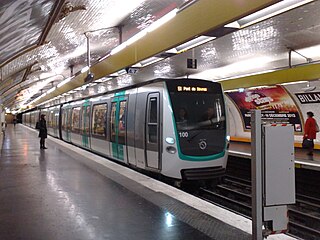
Paris Métro Line 9 is one of 16 lines of the Paris Métro. The line links Pont de Sèvres in Boulogne in the west with Mairie de Montreuil in the east via the city center of Paris, creating a parabola type shape to its route. It is the third busiest line on the network.
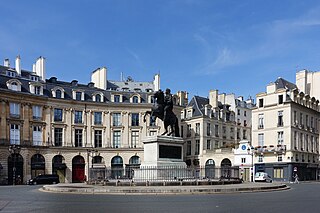
The Place des Victoires is a circular place in Paris, located a short distance northeast from the Palais Royal and straddling the border between the 1st and the 2nd arrondissements. The Place des Victoires is at the confluence of six streets: Rue de la Feuillade, Rue Vide Gousset, Rue d'Aboukir, Rue Étienne Marcel, Rue Croix-des-Petits-Champs, and Rue Catinat.
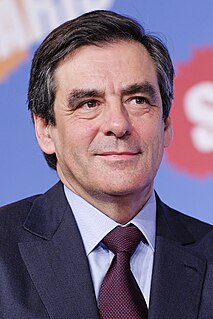
François Charles Armand Fillon is a retired French politician who served as Prime Minister of France from 2007 to 2012 under President Nicolas Sarkozy. He was the nominee of the Republicans, the country's largest centre-right political party, for the 2017 presidential election.
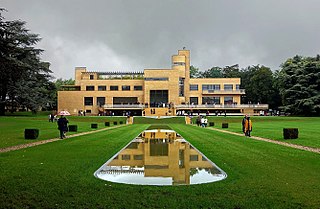
Robert Mallet-Stevens was an influential French architect and designer.

Charvet Place Vendôme, pronounced [ʃaʁvɛ plas vɑ̃dɔm], or simply Charvet, is a French high-end shirt maker and tailor located at 28 Place Vendôme in Paris. It designs, produces and sells bespoke and ready-to-wear shirts, neckties, blouses, pyjamas and suits, in the Paris store and internationally through luxury retailers.
Fred Joaillier, more commonly known as Fred, is a French jewellery and watch brand founded in 1936 by Fred Samuel in Paris and operated by the company Fred Paris.

The Galerie Véro-Dodat is one of the covered passages of Paris. It is located in the 1st arrondissement, connecting the Rue de Jean-Jacques Rousseau and Rue de Croix-des-Petits-Champs. It was built in 1826.

Passage Choiseul is one of the covered passages of Paris, France located in the 2nd arrondissement. It is the continuation of Rue de Choiseul.
André Gattolin is a French ecologist politician and Senator for Hauts-de-Seine.

Georges Louis Jean Baptiste Peignot was a French type designer, type founder, and manager of the G. Peignot & Fils foundry until his death in the World War I. Father of four children, he hoisted the G. Peignot & Fils foundry among the most striking French typography companies of the twentieth century : in 17 years of practice, he created or launched prestigious fonts, including Grasset, Cochin, and Garamont.

Élisabeth Thuillier and Marie-Berthe Thuillier were a mother-daughter team of French colourists. They ran a workshop in Paris, where their employees hand-coloured early films and photographic slides using their plans and colour choices. They are remembered especially for the work they did for the director Georges Méliès.
La République En Marche !, sometimes called simply En Marche ! as its original name, is a centrist and liberal political party in France.

Benjamin-Blaise Griveaux is a French politician of La République En Marche! (LREM) who served as Government Spokesman from 2017 to 2019 under Prime Minister Édouard Philippe. From 2017 until 2021, he also served as a member of the National Assembly, representing the 5th constituency of Paris, which encompasses the 3rd and 10th arrondissements.
The authorities of medieval Paris attempted to confine prostitution to a particular district. Louis IX (1226–1270) designated nine streets in the Beaubourg Quartier where it would be permitted. In the early part of the 19th century, state-controlled legal brothels started to appear in several French cities. By law, they had to be run by a woman and their external appearance had to be discreet. The maisons were required to light a red lantern when they were open (from which is derived the term red-light district and the prostitutes were only permitted to leave the maisons on certain days and only if accompanied by its head. By 1810, Paris alone had 180 officially approved brothels.
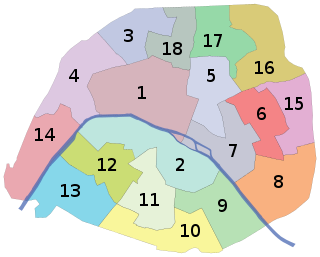
The 17th constituency of Paris is a French legislative constituency in the Paris département (75). Like the other 576 French constituencies, it elects one MP using the two-round system. The constituency, following the 2010 redistricting of French legislative constituencies, consists of part of the 18th arrondissement, comprising the districts of Goutte-d'Or and La Chapelle, and part of the 19th arrondissement, comprising the district of La Villette and a small part of the district of Combat located at west of avenue Secrétan, avenue Simon-Bolivar and rue Henri-Turot, which is almost exactly the area covered by the 1988-2007 19th constituency.
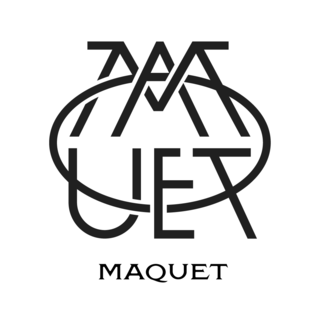
Maquet is a French manufacturer of luxury stationery, leather goods, and art prints, established in Paris in 1841 by the Maquet brothers, Hector and Charles. One of the most renowned Parisian luxury houses, Maison Maquet became official purveyor to Empress Eugénie as well as to several royal courts, winning multiple awards and medals at various World's fairs over the course of its history.

The Art Deco movement of architecture and design appeared in Paris in about 1910–12, and continued until the beginning of World War II in 1939. It took its name from the International Exposition of Modern Decorative and Industrial Arts held in Paris in 1925. It was characterized by bold geometric forms, bright colors, and highly stylized decoration, and symbolized modernity and luxury. Art Deco architecture, sculpture, and decoration reached its peak at 1939 Exposition Internationale des Arts et Techniques dans la Vie Moderne, and in movie theaters, department stores, other public buildings. It also featured in the work of Paris jewelers, graphic artists, furniture craftsmen, and jewelers, and glass and metal design. Many Art Deco landmarks, including the Théâtre des Champs-Élysées and the Palais de Chaillot, can be seen today in Paris.

Marie-Thérèse Auffray was a French painter and fighter in the French Resistance during World War II. She began her career in the 14th arrondissement of Paris and was known for her expressionist works. She remained independent of the art market, whose mercantile codes she always rejected.















